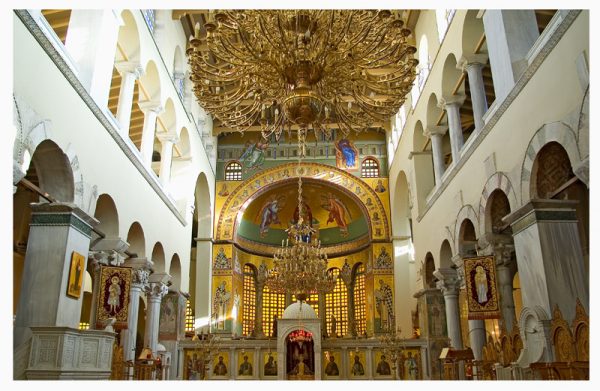The Church of Saint Demetrius is the main sanctuary dedicated to Saint Demetrius, the patron saint of Thessaloniki (in Central Macedonia, Greece), dating from a time when it was the second largest city of the Byzantine Empire. It is part of the site Palaeochristian and Byzantine Monuments of Thessaloniki on the list of World Heritage Sites by UNESCO since 1988.
The basilica is famous for six extant mosaic panels, dated to the period between the latest reconstruction and the inauguration of the Iconoclastic policies in 730. These mosaics, depicting St. Demetrius with officials responsible for the restoration (called the founders) and with children, represent rare examples of art surviving from the Dark Age that followed Justinian’s death.

Following the Great Fire of 1917, it took decades to restore the church. Tombstones from the city’s Jewish cemetery were used as building materials in these restoration efforts in the 1940s. Archeological excavations conducted in the 1930s and 1940s revealed interesting artifacts that may be seen in a museum situated inside the church’s crypt. The excavations also uncovered the ruins of a Roman bath, where St. Demetrius was said to have been held prisoner and executed. A Roman well was also discovered. Scholars believe this is where soldiers dropped the body of St. Demetrius after his execution. After restoration, the church was reconsecrated in 1949.

Underneath the Church of St Demetrios is the place where St Demetrios, Thessaloniki’s patron saint, was martyred. As the level of the ground gradually rose over the centuries, this area acquired the form of a crypt. According both to tradition and to archaeological findings, it was an old bathhouse, in which Demetrios was imprisoned and eventually martyred in 303 AD. In the 5th century, when the first Church of St Demetrios was built, the site of his martyrdom was incorporated into the church and the fountain was converted into a source of holy water. In the years that followed, the fountain acquired basins, from which the faithful could collect myron, the sweet-smelling oil produced by the saint’s relics. The crypt filled up with earth during the period of Ottoman rule and was not rediscovered until after the fire of 1917. It has been restored by the Archaeological Service and was converted into an exhibition space in 1988.

Transfer Thessaloniki is the best way to visit this historical church! We are here to transfer you from Thessaloniki Airport to Saint Demetrius. Your transfer, is our pleasure!
